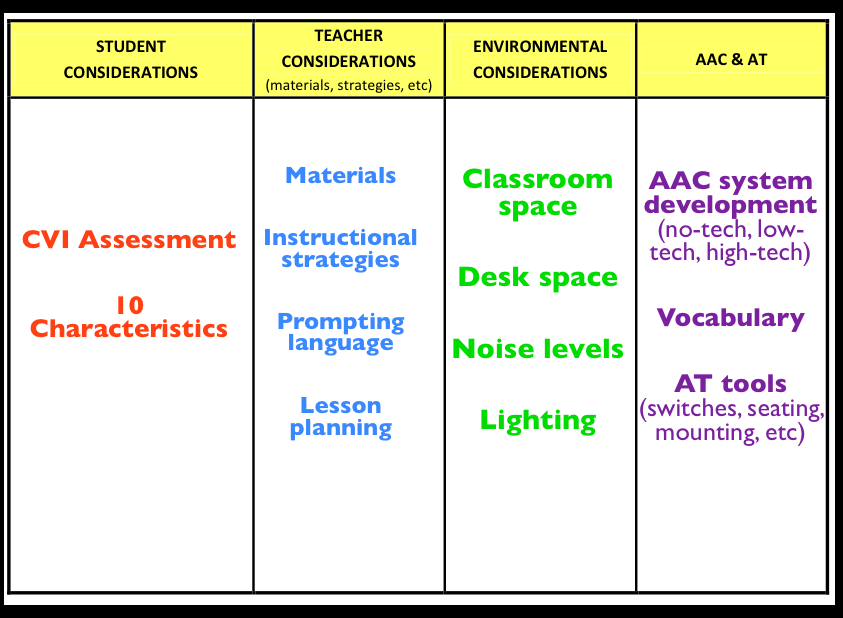The preschool is a busy place full of young learners accessing a comprehensive curriculum. For many young learners, preschool is their first school experience and there is so much to do and learn. Given their age, lots of learning is done around real objects, real experiences, books, songs, social interactions and negotiations and school expectations within child-directed and teacher-directed activities. For our students they are also learning and utilizing new communication tools and strategies with teachers and friends outside of their family. Their world is growing and with that comes the need to support their growth through appropriate vision accommodations. We identified one child-directed activity – Centers (specifically pretend play and art), and three teacher-directed activities – Music, Storytime, and Morning Circle as times to target using CVI accommodations.
The preschool is a busy place full of young learners accessing a comprehensive curriculum. For many young learners, preschool is their first school experience and there is so much to do and learn. Given their age, lots of learning is done around real objects, real experiences, books, songs, social interactions and negotiations and school expectations within child-directed and teacher-directed activities. For our students they are also learning and utilizing new communication tools and strategies with teachers and friends outside of their family. Their world is growing and with that comes the need to support their growth through appropriate vision accommodations. As you can see In the chart below, we started by identifying 4 times of the day to incorporate at least two CVI accommodations within the routine and to include both child-directed and teacher-directed activities. While it is easier for us to control background noise, overhead lights, etc., during teacher-led routines, as young learners who need to direct their own learning, incorporating easy-to-use and flexible strategies within child-directed activities was important. We then looked at the CVI characteristics charts developed for each student according to The CVI Range to determine which characteristics to target in terms of accommodations. Finally, we stated our lesson objectives to help in planning how to adapt the educational materials, environment and communication tools.
The main purpose of Centers is to allow students the opportunity to play and explore with objects and concepts related to a thematic unit. Students choose between four centers – art, pretend play, computer or book area. Each center has activities related to the theme. Themes change every two weeks and include camping, veterinarian’s office, community helpers, bakery and service station. Centers is a 45 minute, child-directed activity, where the child chooses what activities to participate in.
| Scheduled Activity | CVI Characteristics to Target | Lesson Objectives |
|---|---|---|
|
|
Students will engage with props, play materials and art tools to act out thematic play schemas. |
Music is a 15-20 minute, teacher-led, daily activity. Children enjoy singing and moving to songs that integrate theme-related concepts, props and vocabulary.
| Scheduled Activity | CVI Characteristics to Target | Lesson Objectives |
|---|---|---|
|
|
Students will participate in a song that relates to the thematic unit. |
Storytime is a teacher-led activity, lasting 15-20 minutes, that encourages students to listen to, enjoy and respond to a book, while also reinforcing vocabulary concepts and knowledge related to the theme. One book is chosen for the duration of the theme so that students have multiple exposures and experiences with the same content.
| Scheduled Activity | CVI Characteristics to Target | Lesson Objectives |
|---|---|---|
|
|
Students will participate with a book that relates to the thematic unit. |
When the preschool children first arrive at school, Morning Circle provides a familiar structured routine to help them transition from the home to school environment. Morning Circle routines may include attendance, calendar/schedule, weather graph and songs.
| Scheduled Activity | CVI Characteristics to Target | Lesson Objectives |
|---|---|---|
|
|
Students will orient to the day in a routine activity that welcomes them to school. |

We then created and mapped the accommodations according to each student on this planning intervention guide that could be shared across staff as they planned lessons, adapted materials, implemented lessons and developed communication tools.


